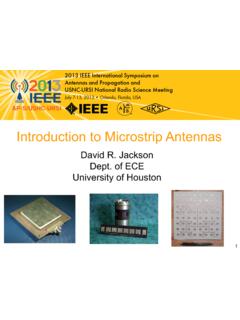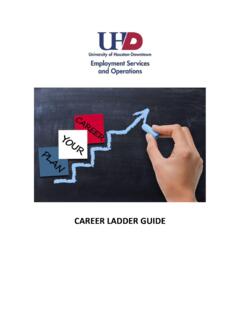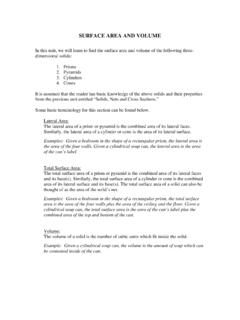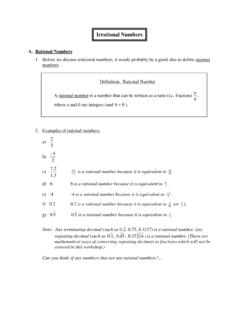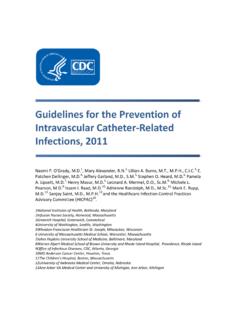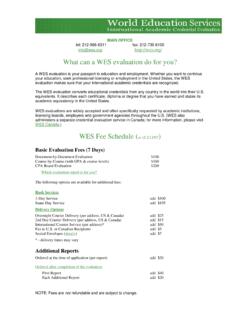Transcription of Chapter 2: Circuit Elements - University of Houston
1 Chapter 2: Circuit Elements Objectives o Understand concept of basic Circuit Elements Resistor, voltage source, current source, capacitor, inductor o Learn to apply KVL, KCL, Ohm s Law Sign conventions Homework/Quiz/Exam Prep o When do we have enough equations? o Math requirements Simultaneous linear algebraic equations Presentation o Ideal Basic Circuit Elements Sources: Dependent and Independent R, L, C o Resistors Ohm s Law Power o Flashlight Circuit KVL, KCL, Ohm KVL shortcut o Special Cases Short Circuit ; Open Circuit What happens to resistors that are shorted/opened? Activity: worksheet on KVL, KCL, Ohm Activity: sample problems Chapter 2: Circuit Elements There are five Ideal Basic Circuit Elements . We listed these in the previous Chapter ; we discuss them further here. The Ideal Basic Circuit Elements are as follows. Voltage source Current source Resistor Capacitor Inductor These Circuit Elements are used to model electrical systems, as we discussed in Chapter 1.
2 They are available in the laboratory, but the ones in the lab are not ideal ; they are real . When we draw Circuit models on the board or in quizzes and exams, we assume that ideal Elements are intended, unless otherwise stated. To solve circuits involving capacitors and inductors, we require differential equations. Therefore we will postpone these Circuit Elements until later in the course and deal for the moment with sources and resistors only. Sources Source: a device capable of conversion between non-electrical energy and electrical energy. Generator: mechanical electrical Motor: electrical mechanical Important: energy and power can be either delivered or absorbed, depending on the Circuit element and how it is connected into the Circuit . We will deal with two kinds of sources: Dependent and Independent Dependent Source: a source whose value depends on a voltage or current elsewhere in the Circuit . Independent Source: a source whose value does is independent of any other voltages or currents in the Circuit .
3 Voltage Sources: In general, there will be a current flowing through a voltage source. That current can be positive, negative, or zero, depending on how the source is connected into the Circuit . Ideal Independent Voltage Source The ideal independent voltage source maintains a fixed voltage across its terminals regardless of the current through it. Ideal Dependent Voltage Source The ideal dependent (or controlled) voltage source maintains a voltage across its terminals that depends on either a voltage or current elsewhere in the Circuit . Thus sxvv or xsiv where vx (ix) is a voltage (current) somewhere else in the Circuit , and and are constants. Also note that is dimensionless but has dimensions [Volts/Amp] (it multiplies a current but the resultant unit must be Volts). vsis-+vsisCurrent Sources: In general, there will be a voltage across a current source. That voltage can be positive, negative, or 0 depending on how it is connected into the Circuit .
4 Ideal Independent Current Source The ideal independent current source maintains a fixed current through its terminals regardless of the voltage across it. Ideal Dependent Current Source The ideal dependent (or controlled) current source maintains a current through its terminals that depends on either a voltage or current elsewhere in the Circuit . Thus xsvi or xsii where vx (ix) is a voltage (current) somewhere else in the Circuit , and and are constants. Also note that is dimensionless but has dimensions [Amps/Volt] (it multiplies a voltage but the resultant unit must be Amps). isvS-+isvS-+ Electrical Resistance; Ohm s Law Resistance: The characteristic of a material by which it impedes the flow of current. Resistor: A basic Circuit element that models resistance; it is characterized by its resistance R in Ohms [ ]. For an ideal resistor, R is constant regardless of the current through or voltage across it.
5 The voltage across a resistor is related to the current through it. The relationship is called Ohm s Law, which states that for a resistor, the ratio of the voltage to the current is the resistance. In other words RRivR and R is constant. We generally assume that R is positive. But remember that the voltage and current polarities labeled in the figure above are simply reference polarities: the voltage vR and current iR can be either positive or negative. To make sure R is positive, we have to have a sign Sign Conventions In the drawing to the left, the current reference is in the direction of the voltage reference drop (passive sign convention). For this case, we write Ohm s Law as .RivRR In the drawing to the right, the current reference is in the direction of the voltage reference rise (active sign convention). In that case, Ohm s Law becomes .RivRR RvR+-iRRvR+-iRRvR+-iRSome very important notes: Q: Why do we need two of Ohm s Law?
6 Can t we just have Riv ? A: We are free to label the resistor voltage and current in either the active or the passive convention. But the value of R is assumed to be positive, so we have to adjust Ohm s law with a sign, to avoid having the ratio of the voltage to the current come out negative. Ohm s Law holds only for resistors. It is a common error to assume that Ohm s Law holds for voltage sources and current sources. Students try to find a resistance for a voltage source and then figure out the current. This cannot be done; there is no such relationship for voltage sources. Similarly you cannot define a resistance for a current source using Ohm s law, because Ohm s law does not hold for current sources. A Common Error Concerning Voltage Sources Sometimes a student will assume that the current through a voltage source must be going one way or another because of the source polarity. This is wrong-thinking. The current through a voltage source can go in either direction, or it could be 0.
7 A Common Error Concerning Current Sources Another common error is to that there is no voltage across a current source. The voltage across a current source might be zero, but in general it is not. Only Kirchhoff s Voltage Law can tell us what it is, as we shall see later on. Conductance We often find it convenient to define the conductance, which is the reciprocal of resistance..1RG The units of conductance are Siemens, or Mho s (1/ ). Power for a resistor Recall from Chapter 1 the rules for getting the equation for absorbed power. Here is a Circuit element E . Now imagine that the Circuit element is a resistor with resistance R. Then for the box on the left, we have, with vE = vR and iE = iR RRRabsivp , and from Ohm s Law: .RivRR If we use the second equation to eliminate vR from the first one, we get .2,RipRRabs If we use second equation to eliminate i from the first one, we get .2,RvpRRabs In either case, note that the absorbed power pabs,R is always positive, as it should be for a resistor.
8 If we consider the box on the right (previous page), we have RRRabsivp , RivRR In this case, substitution of the second equation into the first gives the same results as before, as it should. This is an example of how the rules for dealing with signs lead us to the correct results. EvE-+iEEiEvE-+EEEabsivp ,EEEabsivp , Construction of a Circuit Model Suppose we want to construct a Circuit model for a flashlight. What are the important components? Batteries: vs Filament (lamp): RL Case: Rc Switch Coil: R1 We can model the batteries with a voltage source. The other components can be modeled with resistors, except for the switch. The switch is nothing more than a connection that can be either open (off) or closed (on). The filament is more than a resistor: it gives off light and heat. However, we are interested in only electrical behavior, so we will ignore those properties and stick with the resistor as a model.
9 How do we connect these Elements together? An examination of a flashlight shows that these things are connected in series (more on that later), which is to say they are connected end-to-end. The following diagram results. vsR1 RcRL This is a Circuit model for a flashlight. We have made some assumptions The switch is ideal and has no resistance when it is closed, and an infinite resistance when it is open. Real switches have some small resistance when closed, and a large but finite resistance when open. The batteries are ideal: the voltage does not depend on the fact that current is flowing through them, which is not the case for real batteries. We use a resistor, which has constant R, to model the lamp. In fact, the resistance of a real flashlight lamp changes a little when current flows through it. We will ignore that detail here. Now what? We want to solve this Circuit . That means we want to know all the voltages and currents associated with all the Circuit Elements .
10 To do that, we need to know something more about the voltages and currents in this Circuit . That information comes from Kirchhoff s Laws. Kirchhoff s Laws We now assume the switch on the flashlight is closed, so the flashlight is on. Then each of the Circuit Elements will have a voltage across it and a current through it, which we need to find. The voltages and currents are labeled below. Note that the voltage polarities and current directions are arbitrary; I can label them any way I like How many unknowns do we have? There are seven: i1, ic, iL, is, v1, vc, and vL (vs and the resistances assumed to be known). That means we need seven equations. We can use Ohm s Law to get three equations, but we need more. 111 Riv cccRiv LLLRiv . Activity Students will do this at their desks with TA assistance. Kirchhoff s Current Law Kirchhoff s Current Law (KCL) puts constraints on the currents in a Circuit . Before we can state it we need a definition: Definition: A node is a place on the Circuit where two or more Circuit Elements join.





